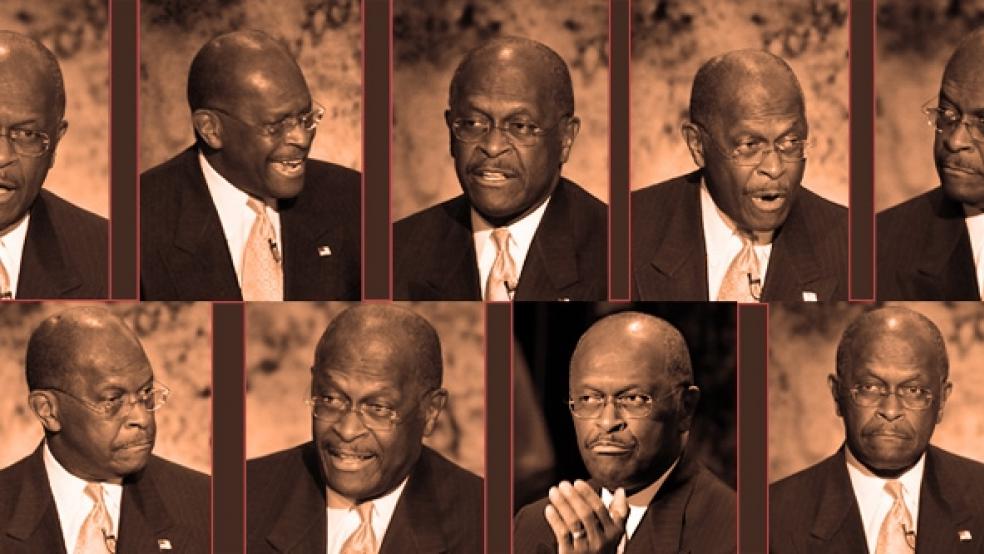Herman Cain, now the leader among Republican presidential candidates,l got exactly what he wanted from Tuesday night’s GOP debate in New Hampshire – a robust showcasing of his 9-9-9 plan. The liberal blog Think Progress counted how often Cain, the moderators, and other Republican candidates said the word “nine”; the final count was 85 times. Cain even used his chance to question a fellow candidate to get Mitt Romney on the record about his own 59-point economic plan. Then Cain argued that the Romney plan lacked both specificity and simplicity.
Cain says that the simplicity and boldness of 9-9-9 will make it appealing to voters across the nation. But it’s that boldness – and especially that final 9 – that has some conservatives concerned. The plan would impose a 9 percent tax on personal income, a 9 percent tax on corporate income, and a 9 percent national sales tax; it would scrap the rest of the tax code, including taxes on dividends and capital gains, and ditch all deductions.
First, it’s instructive to note what 9-9-9 is and is not. It is not a comprehensive economic plan. It’s actually not even a budget plan. That’s why Cain’s challenge to Romney in the debate was somewhat unfair; Romney’s 160-page proposal is a broad economic plan with specifics on deficit reduction and entitlement reform, trade and energy policy. 9-9-9 is more properly categorized as tax reform.
9-9-9 is also transitional tax reform, not the end goal. On Cain’s website, he describes 9-9-9 as merely Phase 1 of tax reform. The final stage of Cain’s tax vision is the Fair Tax proposal pushed by Mike Huckabee in the 2008 election cycle, which is a consumption tax modeled on the European value-added tax (VAT). Cain developed the 9-9-9 plan to “unite the ‘Flat Taxers’ with the ‘Fair Taxers.’”
The Fair Taxers conceded during the run-up to the 2008 presidential election that we might need to get to a flat tax as a transitional stage to a consumption tax, simply to stop the damage done from the overly complicated and politically skewed personal and corporate tax systems. However, that concession still retained the firewall against creating a new form of federal taxation while keeping the old one. The Fair Tax proposal in 2008 envisioned a trigger that could not get pulled until after the repeal of the 16th Amendment, the legal foundation for the federal income tax. Instead of retaining that firewall, 9-9-9 asks voters to trust that we can overlap a federal sales tax and an income tax while Congress eliminates the latter in Phase II of Cain’s plan.
Needless to say, even Herman Cain might not have the sales skills to sell: “I’m from the government, and I’m here to help.” Conservatives have opposed a federal VAT for many years and became especially sensitive to it in 2009 when then-Speaker Nancy Pelosi began suggesting that it be implemented as a means to pay for the health-care reform bill popularly known as ObamaCare. That is why the repeal of the 16th Amendment as a trigger for the Fair Tax was so essential to keeping a federal sales tax from becoming an additional income stream for Washington.
It isn’t too difficult to imagine what could go wrong in Cain’s scenario. Congress could pass Phase I of Cain’s plan and never bother to move to Phase II. In fact, that seems more likely than not, since repealing the 16th Amendment would require ratification by two-thirds of each chamber of Congress and three-quarters of the states -- a process that could take more years than Cain would be President. Could we find a two-thirds majority willing to dump the progressive tax system – which allows politicians to conduct social engineering as well as build in benefits for campaign donors – in even the most reform-minded Congress?
If Cain could get Phase I passed, which would be no easy feat, Congress would then have the ability to raise rates in both streams, and still later revert to a progressive income-tax system with the middle “nine.” That would mean we would return to the same problems we have now, except with a new sales tax that would arguably be regressive in its impact. Cain argues that the elimination of taxes on estates, payroll, capital gains, and repatriated profits would negate that impact, but most of those taxes don’t have a direct effect on working-class families the way a sales tax undoubtedly would.
Finally, without a specific constitutional amendment authorizing it, a federal sales tax on general purchases would get challenged by small-government federalists on principle. Unless the sale crosses state lines, it is difficult to see federal jurisdiction at the cash register for most transactions. Accepting that Congress can impose a sales tax on transactions at the local grocery store without a Constitutional amendment granting such authority would require conservatives to embrace a Wickard v Filburn philosophy of interstate commerce. Since a rejection of that philosophy is at the heart of conservative opposition to ObamaCare and its mandate, don’t expect conservatives to leap for joy at the thought of a new definition of interstate commerce that fits the final “nine” in Cain’s plan.
Perhaps Cain might rethink 9-9-9 and propose instead a plan that only provides a flat tax for corporate and personal income, either as a transition to the Fair Tax or as an end unto itself. A 14-14 Plan or a 15-15 Plan might not sound as catchy for campaigning, but it would make a more sensible tax-reform plan for actual public policy – and it would appeal to conservatives more than adding a new, constitutionally suspect sales tax.






